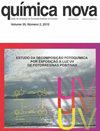吉尔伯特·牛顿·刘易斯的文章《酸与碱》的评论翻译
IF 0.5
4区 化学
Q4 CHEMISTRY, MULTIDISCIPLINARY
引用次数: 0
摘要
吉尔伯特·牛顿·刘易斯对酸和碱的注释翻译。吉尔伯特·牛顿·刘易斯是20世纪化学史上一位杰出的科学家。他的工作至今仍与物理化学、有机化学和配位化学有关。路易斯因提出基于电子共享的化学键而闻名。1923年,他发表了关于酸和碱的两种理论解释:前者与Bronsted和Lowry合作,后者在他的著作《价与原子和分子的结构》(1923)中发表。在这本书中,强调了电子对在酸碱反应中的作用,并从氢离子的分离/转移中进行了分散性解释。因此,更多的物质可以被归类为酸和碱。同时,在有机化学和配位化学的背景下,对反应机理也有了新的解释。在这里翻译的论文《酸与碱》(1938)对酸与碱的行为作了强有力的经验描述。刘易斯设计了现象学标准,如中和反应的速度、酸碱滴定的强度及其作为催化剂的应用。在这份手稿中,我们对1938年出版的刘易斯酸碱进行了评论翻译,认为它是葡萄牙语国家研究和教育应用的鼓舞人心的来源。本文章由计算机程序翻译,如有差异,请以英文原文为准。
UMA TRADUÇÃO COMENTADA DO ARTIGO “ÁCIDOS E BASES” DE GILBERT NEWTON LEWIS
A COMMENTED TRANSLATION OF ACIDS AND BASES BY GILBERT NEWTON LEWIS. Gilbert Newton Lewis was a distinguished scientist in 20th century History of Chemistry. His work remains relevant for physical chemistry, organic chemistry and coordination chemistry nowadays. Lewis is well known by his propose for chemical bond, based on electron sharing. In 1923 he published two theoretical explanations for acids and bases: the former collaborating with Bronsted and Lowry and the later in his book Valence and the Structure of Atoms and Molecules (1923). In this book, the role of electron pairs in acid base reactions was highlighted decentering explanations from detachment/transfer of hydrogen ion. As a result, more substances could be classified as acids and bases. Also, in the context of organic and coordination chemistry new interpretations for reaction mechanisms showed up. The paper translated here, Acids and Bases (1938), makes a strong empirical description of acids and bases behavior. Lewis designed phenomenological criteria as speed of neutralization reactions, strength of the species acid-base titrations, and its applications as catalysts. In this manuscript, we carried out a commented translation of Lewis Acids and Bases published in 1938, considering it an inspiring source for research and educational applications for Portuguese speaking countries.
求助全文
通过发布文献求助,成功后即可免费获取论文全文。
去求助
来源期刊

Quimica Nova
化学-化学综合
CiteScore
1.60
自引率
12.50%
发文量
72
审稿时长
2-4 weeks
期刊介绍:
Química Nova publishes in portuguese, spanish and english, original research articles, revisions, technical notes and articles about education in chemistry. All the manuscripts submitted to QN are evaluated by, at least, two reviewers (from Brazil and abroad) of recognized expertise in the field of chemistry involved in the manuscript. The Editorial Council can be eventually asked to review manuscripts. Editors are responsible for the final edition of QN.
 求助内容:
求助内容: 应助结果提醒方式:
应助结果提醒方式:


